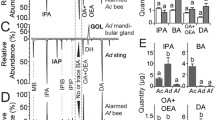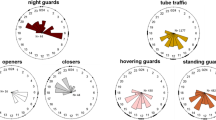Abstract
Lestrimelitta spp. are stingless bees that steal food and nesting materials from other highly social bees to survive. Though most of their victim species respond, either aggressively or submissively, to cephalic components of Lestrimelitta, little is known about if such response changes at some point during extended periods of exposure. Moreover, potential synergistic effects due to a mixture of victim’s alarm/defense pheromones and Lestrimelitta mandibular pheromones, like in an actual attack, have not been examined so far. In this paper, we investigated the response of two species of non-robber stingless bees, Scaptotrigona mexicana (Guérin) and Tetragonisca angustula (Latreille), to (a) cephalic compounds from crushed heads of nestmates, (b) cephalic compounds of Lestrimelitta niitkib (Ayala), and (c) a mixture of (a) and (b). We found that even though T. angustula did not react to nestmates’ crushed head, its response towards L. niitkib cephalic compounds was stronger and lasted longer than that of S. mexicana. Interestingly, the addition of crushed heads of the non-robber species to L. niitkib crushed heads caused no significant increase in the alarm response of both species. It may be that the absence of an alarm pheromone in T. angustula made this species more receptive to extraneous odors, which is not the case for S. mexicana; however, more species must be studied to elucidate any pattern regarding the absence/presence of alarm pheromones and the corresponding response to intruders’ pheromones.

Similar content being viewed by others
References
Ayala R (1999) Revisión de las abejas sin aguijón de México (Hymenoptera: Apidae: Meliponini). Folia Entomol Mex 106:1–123
Bates D, Maechler M, Bolker B, Walker S (2015) Fitting linear mixed-effects models using lme4. J Stat Softw 67:1–48
Bego LR, Zucchi R, Mateus Z (1991) Notas sobre a estrategia alimentar (cleptobiose) de Lestrimelitta limao Smith (Hymenoptera, Apidae, Meliponinae). Naturalia 16:119–127
Bray A, Nieh J (2014) Non-consumptive predator effects shape honey bee foraging and recruitment dancing. PLoS One 9(1):e87459
Breed MD, Cook C, Krasnec MO (2012) Cleptobiosis in social insects. Psyche 2012:1–7
Chivers DP, Brown GE, Smith RJF (1996) The evolution of chemical alarm signals: attracting predators benefits alarm signal senders. Am Nat 148:649–659
Dejean A, Carpenter JM, Corbara B, Wright P, Roux O, LaPierre LM, Rasmussen C, Velasquez A (2012) The hunter becomes the hunted: when cleptobiotic insects are captured by their target ant. Naturwissenschaften 99:265–273
Delignette-Muller ML, Dutang C (2015) Fitdistrplus: an R package for fitting distributions. J Stat Softw 64:1–34
Gonzalez VH, Rasmussen C, Velasquez A (2010) Una especie nueva de Lestrimelitta y un cambio de nombre en Lasioglossum (Hymenoptera: Apidae, Halictidae). Rev Colomb Entomol 36:319–324
Grüter C, Menezes C, Imperatriz-Fonseca VL, Ratnieks FLW (2012) A morphologically specialized soldier caste improves colony defense in a neotropical eusocial bee. Proc Natl Acad Sci 109:1182–1186
Grüter C, von Zuben LG, Segers FHID, Cunningham JP (2016) Warfare in stingless bees. Insect Soc 63:223–236
Grüter C, Segers FH, Menezes C, Vollet-Neto A, Falcón T, von Zuben L, Bitondi MM, Nascimento FS, Almeida EA (2017) Repeated evolution of soldier sub-castes suggests parasitism drives social complexity in stingless bees. Nat Commun 8:4
Jack-McCollough RT, Nieh JC (2015) Honeybees tune excitatory and inhibitory recruitment signalling to resource value and predation risk. Anim Behav 110:9–17
Jeanne RL (1981) Alarm recruitment, attack behavior, and the role of the alarm pheromone in Polybia occidentalis (Hymenoptera: Vespidae). Behav Ecol Sociobiol 9:143–148
Leonhardt SD (2017) Chemical ecology of stingless bees. J Chem Ecol 43:385–402
Li J, Wang Z, Tan K, Qu Y, Nieh JC (2014) Giant Asian honeybees use olfactory eavesdropping to detect and avoid ant predators. Anim Behav 97:69–76
Mérida-Rivas JA. (2005) Compuestos cefálicos de Lestrimelitta niitkib y su efecto en el comportamiento de defensa en Scaptotrigona mexicana y Tetragonisca angustula, Área de Biotecnología, Campus IV, Universidad Autónoma de Chiapas, Tapachula, Chiapas, Mexico, p 32
Nieh J, Barreto L, Contrera F, Imperatriz-Fonseca V (2004) Olfactory eavesdropping by a competitively foraging stingless bee, Trigona spinipes. Proc R Soc Lond B Biol Sci 271:1633–1640
Ono M, Terabe H, Hori H, Sasaki M (2003) Insect signalling: components of giant hornet alarm pheromone. Nature 424:637–638
Pompeu MS, Silveira FA (2005) Reaction of Melipona rufiventris Lepeletier to citral and against an attack by the cleptobiotic bee Lestrimelitta limao (Smith) (Hymenoptera: Apidae: Meliponini). Braz J Biol 65:189–191
Quezada-Euán JJG, González-Acereto JA (2002) Notes on the nest habits and host range of cleptobiotic Lestrimelitta niitkib (Ayala 1999) (hymenoptera: Meliponini) from the Yucatan peninsula, Mexico. Acta Zool Mex 86:245–249
Quezada-Euán JJ, Ramírez GJ, Eltz T, Pokorny T, Medina R, Monsreal R (2013) Does sensory deception matter in eusocial obligate food robber systems? A study of Lestrimelitta and stingless bee hosts. Anim Behav 85:817–823
R Development Core Team. (2012) R: a language and environment for statistical computing, In: R Foundation for Statistical Computing (Ed.), Vienna, Austria
Sakagami SF, Laroca S (1963) Additional observations on the habits of the cleptobiotic stingless bees, the genus Lestrimelitta Friese (Hymenoptera, Apoidea). Journal of the Faculty of Science Hokkaido University Series VI. Zoology 15:319–339
Sakagami SF, Roubik DW, Zucchi R (1993) Ethology of the robber stingless bee, Lestrimelitta limao (Hymenoptera: Apidae). Sociobiology 21:237–277
Sánchez D, Nieh JC, Vandame R (2011) Visual and chemical cues provide redundant information in the multimodal recruitment system of the stingless bee Scaptotrigona mexicana (Apidae, Meliponini). Insect Soc 58:575–579
Schorkopf DLP, Hrncir M, Mateus S, Zucchi R, Schmidt VM, Barth FG (2009) Mandibular gland secretions of meliponine worker bees: further evidence for their role in interspecific and intraspecific defence and aggression and against their role in food source signalling. J Exp Biol 212:1153–1162
Segers FHID, von Zuben LG, Grüter C (2016) Local differences in parasitism and competition shape defensive investment in a polymorphic eusocial bee. Ecology 97:417–426
Tan K, Hu Z, Chen W, Wang Z, Wang Y, Nieh JC (2013) Fearful foragers: honey bees tune colony and individual foraging to multi-predator presence and food quality. PLoS One 8(9):e75841
van Zweden JS, Grüter C, Jones SM, Ratnieks FLW (2011) Hovering guards of the stingless bee Tetragonisca angustula increase colony defensive perimeter as shown by intra- and inter-specific comparisons. Behav Ecol Sociobiol 65:1277–1282
von Zuben L, Schorkopf D, Elias L, Vaz A, Favaris A, Clososki G, Bento J, Nunes T (2016) Interspecific chemical communication in raids of the robber bee Lestrimelitta limao. Insect Soc 63:339–347
Weaver N, Weaver EC, Clarke ET (1975) Reactions of five species of stingless bees to some volatile chemicals and to other species of bees. J Insect Physiol 21:479–494
Wittmann D (1985) Aerial defense of the nest by workers of the stingless bee Trigona (Tetragonisca) angustula (Latreille) (Hymenoptera: Apidae). Behav Ecol Sociobiol 16:111–114
Wittmann D, Radtke R, Zeil J, Lübke G, Francke W (1990) Robber bees (Lestrimelitta limao) and their host chemical and visual cues in nest defense by Trigona (Tetragonisca) angustula (Apidae: Meliponinae). J Chem Ecol 16:631–641
Acknowledgements
We appreciate the help of Dr. James Nieh, Tyler Jack McCollough, Erik de Jesús Solórzano, Miguel Guzmán, Ricardo Toledo, Julieta Grajales, and Leonardo Daniel Arévalo Monterrubio. This study was possible thanks to the support of SEP-CONACYT agreement no. 128702 “Evolución de la cleptobiosis en Lestrimelitta”, UC-MEXUS project “Olfactory eavesdropping and against a cleptoparasite, Lestrimelitta niitkib” and COCYTECH for the support granted to Dr. Daniel Sánchez through the “Sistema Estatal de Investigadores de Chiapas.”
Author information
Authors and Affiliations
Corresponding author
Additional information
Edited by Fábio S Nascimento – FFCLRP/USP
Rights and permissions
About this article
Cite this article
Campollo-Ovalle, A., Sánchez, D. Temporal Response of Foragers and Guards of Two Stingless Bee Species to Cephalic Compounds of the Robber Bee Lestrimelitta niitkib (Ayala) (Hymenoptera, Apidae). Neotrop Entomol 47, 791–797 (2018). https://doi.org/10.1007/s13744-018-0599-2
Received:
Accepted:
Published:
Issue Date:
DOI: https://doi.org/10.1007/s13744-018-0599-2




